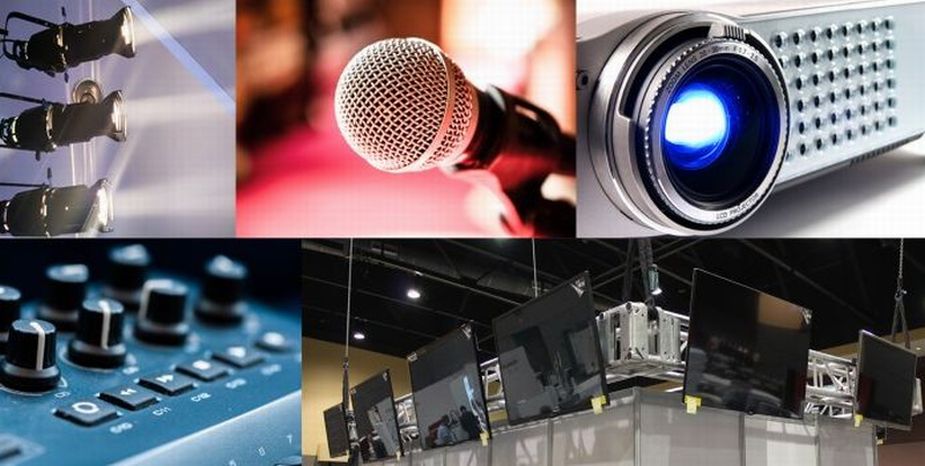The hidden benefits of using audio visual charlotte nc for training sessions
Understanding the Addition of Audio Visual Modern technology in Today's Educational Environments
The combination of audio-visual innovation in educational settings has changed the teaching and learning process. Educators now have accessibility to tools that deal with various learning styles, enhancing trainee interaction and collaboration. Nonetheless, the incorporation of these innovations presents both chances and obstacles. Recognizing how to properly implement these devices is important. What methods can teachers use to make the most of the advantages of audio-visual innovation in their classrooms?
The Development of Audio-Visual Modern Technology in Education
As educational needs advanced over the decades, audio-visual technology undertook considerable transformations that improved the knowing atmosphere. Devices such as film projectors and slide shows were the primary ways of integrating visual aspects into classrooms. These very early modern technologies given educators with the capacity to present information dynamically, yet they were restricted in accessibility and interactivity.
With the development of video clip cassette recorders in the 1970s, class started to incorporate taped lessons, broadening the extent of educational resources. The introduction of computers in the 1980s additional revolutionized this landscape, allowing for the development of multimedia presentations and interactive understanding experiences.
The rise of the net in the 1990s marked an essential moment, enabling real-time access to a wealth of audio-visual materials. Today, electronic devices such as interactive whiteboards and on-line discovering platforms remain to improve the educational experience, promoting involvement and collaboration amongst students.
Advantages of Audio-Visual Equipment for Diverse Understanding Styles
Audio-visual tools play a crucial role in satisfying diverse discovering styles by improving visual understanding and enhancing auditory involvement. By incorporating photos, videos, and sound, these innovations produce an even more comprehensive academic setting. This complex technique permits teachers to attend to the different preferences and needs of students successfully.
Enhancing Visual Understanding
Involvement in the understanding procedure is significantly boosted with the use of audio-visual devices, accommodating numerous finding out styles. These tools, such as videos, infographics, and interactive discussions, give visual stimulations that assist understanding and retention. Aesthetic students, in specific, benefit from the incorporation of pictures and animations, which can simplify complicated concepts and boost understanding. In addition, audio-visual resources can highlight real-world applications, making finding out more pertinent and engaging. By incorporating color, movement, and noise, instructors can develop a dynamic learning environment that records students' attention and cultivates deeper cognitive links. Inevitably, the strategic usage of audio-visual modern technology not only sustains aesthetic understanding yet additionally improves the overall educational experience for varied learners.
Improving Auditory Engagement
A significant advantage of incorporating audio-visual devices in education is their ability to enhance acoustic involvement among students. These devices, which incorporate multimedia discussions, podcasts, and interactive sound components, accommodate numerous finding out designs, specifically profiting acoustic learners (audio visual charlotte nc). By incorporating sound and narrative, educators can develop immersive experiences that catch pupils' focus and enhance comprehension. This involvement is vital, as it cultivates a deeper understanding of the material and promotes retention. In addition, audio-visual tools can assist in joint learning environments, motivating trainees to join conversations and share their insights. Ultimately, the consolidation of audio-visual innovation not only sustains acoustic engagement but additionally improves the total instructional experience, making finding out more vibrant and efficient for all trainees
Enhancing Involvement Via Interactive Learning

Gamification aspects, such as tests and simulations, can improve inspiration and retention, making discovering a lot more satisfying and efficient. These strategies not only promote cognitive involvement however additionally satisfy diverse learning styles, ensuring that all pupils can take part meaningfully. Because of this, interactive understanding settings cultivate a sense of community and belonging, ultimately leading to improved scholastic outcomes. Through the assimilation of audio visual innovation, educators can transform conventional classrooms right into vivid areas where pupils prosper and proactively shape their instructional trips.
Linking Theory and Exercise With Multimedia Resources
Multimedia resources work as an essential link between academic principles and sensible application in educational settings. By boosting interaction, facilitating collective learning experiences, and supporting diverse understanding styles, these devices create a much more comprehensive and vibrant knowing environment - audio visual charlotte nc. This strategy not just promotes deeper understanding however additionally prepares students for real-world difficulties

Enhancing Interaction Through Multimedia
Engagement in academic settings substantially enhances when trainers incorporate multimedia resources into their training methods. The usage of videos, podcasts, and interactive presentations enhances the finding out experience, permitting trainees to get in touch with the product on several levels. Multimedia sources deal with various learning styles, supplying aesthetic, acoustic, and kinesthetic stimulations that can hold pupils' attention much more successfully than conventional lecture approaches. In addition, these resources can streamline complicated concepts, making them much more accessible and memorable. By integrating multimedia, educators can develop a vibrant classroom environment that cultivates curiosity and motivates students. Ultimately, the calculated usage of audio-visual modern technology offers to link the void between academic understanding and sensible application, improving the educational experience for both instructors and students.
Assisting In Collaborative Knowing Knowledge
Various research studies suggest that collective knowing experiences considerably improve pupil outcomes when incorporated with multimedia resources. Multimedia tools help with interaction among pupils, permitting them to participate in problem-solving and crucial thinking collectively. By using video clip conferencing, collaborative platforms, and interactive presentations, instructors develop atmospheres for synergy and shared discovering. These modern technologies enable trainees to interact their ideas properly and receive instant feedback, cultivating a deeper understanding of the topic. Furthermore, multimedia resources can present intricate concepts in more absorbable formats, promoting discussion and partnership. As an outcome, the mix of collaborative understanding and audio-visual innovation not just enriches the academic experience however likewise prepares trainees for real-world teamwork characteristics, stressing the importance of teamwork and cumulative expertise building and construction.
Sustaining Diverse Knowing Styles
While conventional training techniques typically cater to a restricted series of discovering choices, the combination of audio-visual innovation uses a more inclusive technique to education. By utilizing multimedia sources such as video clips, interactive simulations, and electronic presentations, teachers can here deal with different learning designs, consisting of aesthetic, auditory, and kinesthetic. This flexibility enables set apart instruction, enabling students to engage with material in manner ins which reverberate with their specific preferences. In addition, audio-visual devices can help with deeper understanding by providing several representations of complex principles. Consequently, trainees that might deal with standard techniques can locate different paths to success, fostering a more equitable learning atmosphere that sustains academic achievement for all students.
Challenges in Carrying Out Audio-Visual Modern Technology
Although audio-visual technology holds terrific promise for boosting educational experiences, its implementation frequently runs into significant obstacles. One main concern is the monetary concern connected with acquiring and keeping such devices, which can stress spending plans, especially in underfunded establishments. Additionally, insufficient training for teachers can prevent effective integration, leaving them ill-prepared to make use of the modern technology fully. Technical concerns, such as software application malfunctions and compatibility issues, might also disrupt lessons and discourage both instructors and students. Varying levels of trainee access to innovation outside the class can create variations in learning opportunities. The capacity for over-reliance on modern technology might take away from vital mentor techniques, inevitably limiting the instructional experience. Addressing these challenges calls for a complete approach, consisting of appropriate financing, specialist advancement, and equitable access to sources, to assure that audio-visual modern technology can be leveraged properly in today's instructional settings.
Ideal Practices for Integrating Modern Technology in the Classroom

Additionally, cultivating an interactive setting via collective devices motivates student interaction and involvement. Utilizing diverse audio-visual resources deals with different learning styles, suiting visual, auditory, and kinesthetic learners. Regularly assessing the impact of technology on pupil discovering assists educators fine-tune their strategies and adjust to altering requirements. Including trainees in the choice of innovation advertises ownership and inspiration. By adhering to these finest methods, instructors can produce a vibrant classroom environment that properly integrates modern technology and enhances the instructional experience for all pupils.
The Future of Audio-Visual Modern Technology in Education And Learning
As classrooms increasingly embrace innovation, the landscape of audio-visual tools try this out in education and learning remains to advance (audio visual charlotte nc). Future developments are anticipated to focus on greater interactivity and customization, allowing instructors to customize finding out experiences to specific pupil demands. Innovations such as increased reality (AR) and digital fact (VR) will likely provide immersive knowing atmospheres, boosting student engagement and understanding
Synthetic knowledge (AI) is positioned to play a substantial duty in audio-visual technology by using real-time feedback and adaptive discovering pathways. This combination may aid teachers recognize and address pupil difficulties better. Cloud-based platforms will certainly facilitate easier access to sources and partnership amongst students and educators, regardless of area.
In addition to these technical developments, specialist development for teachers will be crucial, ensuring they are geared up to make use of these devices effectively. Generally, the future of audio-visual modern technology in education and learning assures to develop even more dynamic, comprehensive, and impactful discovering experiences.
Regularly Asked Inquiries
Exactly How Can Teachers Choose the Right Audio-Visual Equipment for Their Class?
Picking proper audio-visual devices needs educators to assess their instructional goals, take into consideration student demands, assess readily available innovation, and seek recommendations from peers or specialists, making sure devices effectively boost learning and interaction within their specific classroom atmosphere.
What Budget plan Considerations Are There for Executing Audio-Visual Technology?
Budget plan considerations for applying audio-visual modern technology include first acquisition prices, upkeep expenses, training for team, and potential software program licensing fees. In addition, long-lasting financial investment in updates and substitutes ought to also be factored right into financial planning.
Are There Specific Training Resources for Educators on Audio-Visual Tools?
Several organizations offer training resources for instructors on audio-visual tools, including on the internet programs, workshops, and training overviews. These resources intend to boost instructors' abilities and self-confidence in effectively integrating modern technology into their teaching methods.
Exactly how Do We Measure the Efficiency of Audio-Visual Modern Technology in Knowing?
Gauging the efficiency of audio-visual technology in learning entails examining trainee interaction, understanding, retention prices, and overall scholastic efficiency. Studies, assessments, and empirical researches can give valuable understandings into its effect moved here on academic outcomes.
What Are Common Misunderstandings About Audio-Visual Technology in Education And Learning?
Typical misunderstandings concerning audio-visual innovation in education and learning consist of the belief that it assures engagement and discovering results, in addition to the presumption that all students benefit just as, neglecting private understanding preferences and demands.